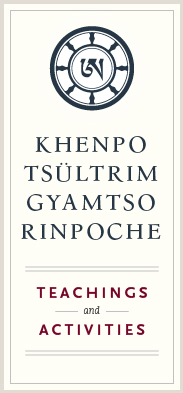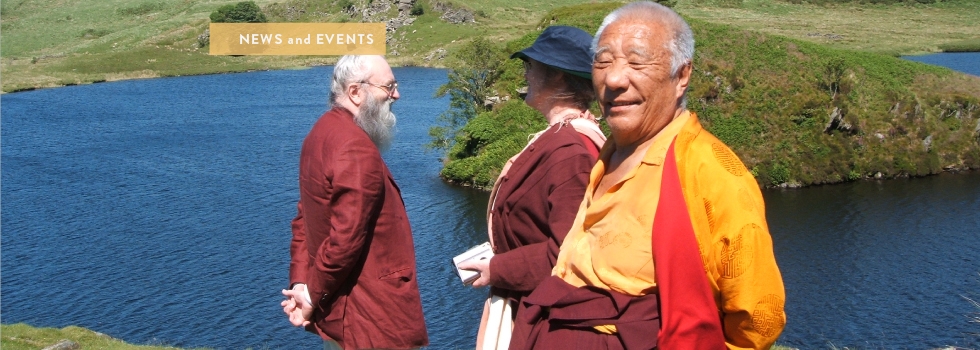You are here
Dian Denis
 In 2004 while visiting Tenerife, Khenpo Rimpoche challenged me to a short debate. Like a sabre cutting through confusion, he started this unexpected moment with a pregnant dharma question about doubts, which stopped my breath and mind. Grasping for air, I looked straight into the accumulation of knowledge and meditation experience he had fostered all these years, and answered in accordance with the teachings on emptiness. He laughed and started his recitation of some traditional verses with a loud 'la- me', which I thought meant that he did not agree, but he was so pleased and the moment so striking that I had to let go. In fact, the answer echoed verses of great masters of the tradition. Was it those of Nagarjuna or others? I was so blown away I can't remember. After the singing of verses, he invited me to translate his teaching in France planned for the following year. Such a short moment in his presence, and life was never the same again.
In 2004 while visiting Tenerife, Khenpo Rimpoche challenged me to a short debate. Like a sabre cutting through confusion, he started this unexpected moment with a pregnant dharma question about doubts, which stopped my breath and mind. Grasping for air, I looked straight into the accumulation of knowledge and meditation experience he had fostered all these years, and answered in accordance with the teachings on emptiness. He laughed and started his recitation of some traditional verses with a loud 'la- me', which I thought meant that he did not agree, but he was so pleased and the moment so striking that I had to let go. In fact, the answer echoed verses of great masters of the tradition. Was it those of Nagarjuna or others? I was so blown away I can't remember. After the singing of verses, he invited me to translate his teaching in France planned for the following year. Such a short moment in his presence, and life was never the same again.
In 2005 in France, he challenged me again, and at the end of this exchange he gave me his vest and instructed me to teach. Later that year, he also encouraged me to pursue my studies at the university level. He pointed out that a subtle analysis of the Chos dang chos nyid rnampar 'byed pa (The Distinction Between Phenomena and their Nature), a Maitreya text I had been working with for three years already, would be most beneficial. When asked questions about certain aspect of this text, he simply instructed me to think about it slowly. That year, I began a doctoral thesis at Laval University in Quebec City and completed it in 2013. Here is an abstract of this work; the link to have access to the document (French) and the link with some the activities inspired by this most powerful Dharma teacher.
ABSTRACT
This study on the Dharmadharmatāvibhāga (DhDhV) looks at the practical aspect of this text. It provides a French translation of the versified version, of the Sanskrit fragments and of Mipham's commentary. It then provides an analysis of the stanzas giving historical and philosophical background according to the work of Bugault, Mathes, Brunnhölzl, etc. More precisely, these translations and analysis look at the Buddhist logical conclusion called 'emptiness' as a key to the adaptability of the Buddhist tradition through time and cultures. How can such a conclusion provide meaning, particularly at this critical time in which our societies are going through profound changes? Even though the idea of emptiness may seem closer to aborting the search for meaning, even though the use of rational mind seems at odds with a conclusion already established, that of emptiness, this research shows that the DhDhV has something important to say about these questions.
http://www.theses.ulaval.ca/2013/29853/
projetsahleo.wordpress.com

